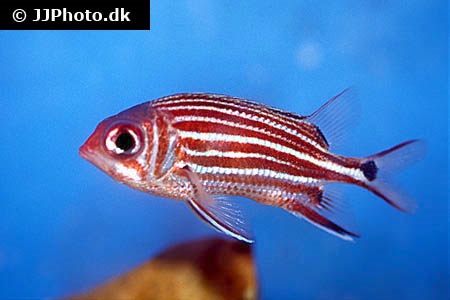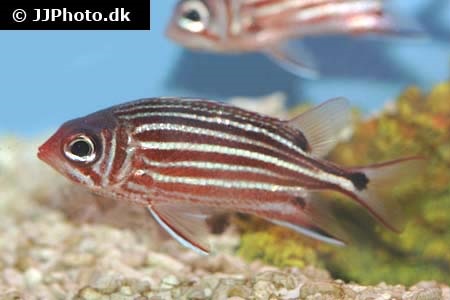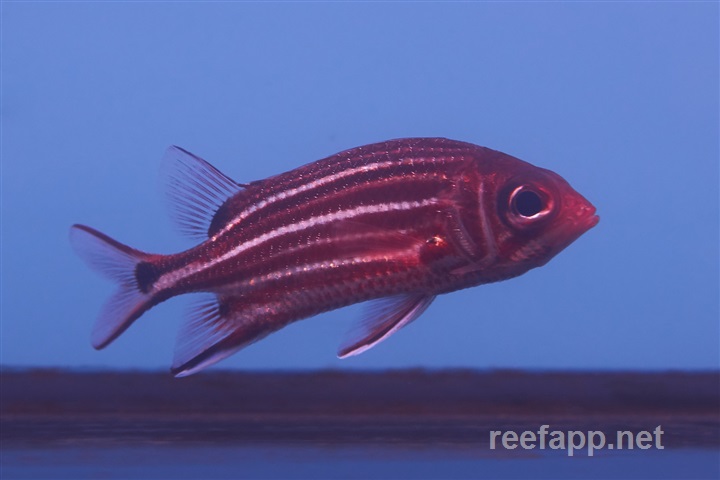Sargocentron cornutum
| Latin name | Sargocentron cornutum - (Bleeker, 1854) |
|---|---|
| Local name | Threespot squirrelfish |
| Family | Holocentridae - Sargocentron |
| Origin | East Indian Ocean, Australia, Indonesia, Central/West Pacific |
| Max length | 27 cm (10.6") |
| Minimum volume |
800 l (211 gal) |
|---|---|
| Hardiness |
Hardy |
| Suitable for aquarium |
Suitable with care |
| Reef safe |
Reef safe with caution |
| Aggressiveness | Might be aggressive |
| Recommended |
Fish Larger crustaceans (Shrimp, crabs...) Other invertebrates Small crustaceans (Krill, mysis, artemia...) |
|---|
This spicies might be a threat to smaller fishes.
This species thrives best in an aquarium with dimmed lighting.
This species can be a threat towards small crustaceans, e.g. small shrimp.
This species is very secretive and will not often be seen out in the open.
These fish should not be caught with a net, as it is all too easy to damage their large eyes.
This species is venomous, but it´s toxin is rarely dangerous to humans. It can however cause considerable pain.
In case of poisoning it is vital to have as much information as possible regarding the species/poison. Have telephone numbers for the poison hotline close to the aquarium.
Since different people can have different reactions to poisons, take precautions necessary to ensure personal safety and that of the surroundings.
This poison can be dangerous if suffering from allergies.
This species thrives best in an aquarium with overhangs and caves.
This species can be aggressive if they are not provided with adequate space.
This species is nocturnal and therefore the most active when the light is dimmed or turned off.
This species likes to hide in and amongst the branches of corals, e.g. Acropora coral and
will also do well if they can find other hiding places.
Squirrel-/Soldierfish (Holocentrinae and Myripristinae) are normally a red/grey colour and very secretive.
As to how much they hide, varies from fish to fish, what they do have in common however, is that they are most active when the lights are off, but will, with time, come out more while the lights are on.
Squirrel-/Soldierfish are not generally a threat to other aquarium animals, but will sometimes eat very small fish and invertebrates.
Neither Squirrelfish or Soldierfish are particularly aggressive, and whilst most species can be kept in a small group, they will sometimes fight amongst themselves. In this case, space must be taken into consideration as the Squirrelfish will sometimes chase the less aggressive Soldierfish, if space is lacking.
It is easy enough to get both fish types to eat, but if they do not come out during the day it is best to feed them when the lights are off. In the beginning it might be necessary to lure them out with live food.
Squirrelfish have spikes on their head and gills which easily get caught in fishnets, so avoid those.
Being scratched by some species of Squirrelfish can result in an ugly wound and be painful, as some are actually poisonous.
If one is not careful when capturing and transporting these fish, their eyes can be damaged.
| Distribution | Western Pacific: Indonesia (including Mentawai Islands), Philippines, Solomon Islands, and Great Barrier Reef. Also reported from Malaysia (Ref. 5756), Tosa Bay, Japan (Ref. 559), and Viet Nam (Ref. 9706). |
|---|---|
| Danish common names |
Treplettet egernfisk |
| English common names |
Threespot squirrelfish Horned squirrelfish |
| French common names |
Écureuil à taches noires |
Scott W. Michael. 2001. Reef Fishes volume 1 - TFH Publications / Microcosm Ltd. - (English)
Henry C. Schultz. 2003. But They Don't Look Like a Rat with a Fuzzy Tail: The Family Holocentridae - Reefkeeping Magazine - (English)
Bob Fenner. Squirrel- & Soldierfishes, Family Holocentridae - Wet Web Media - (English)




